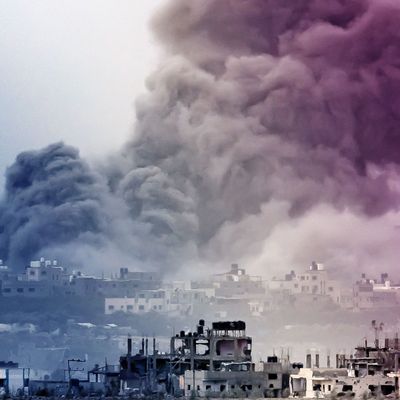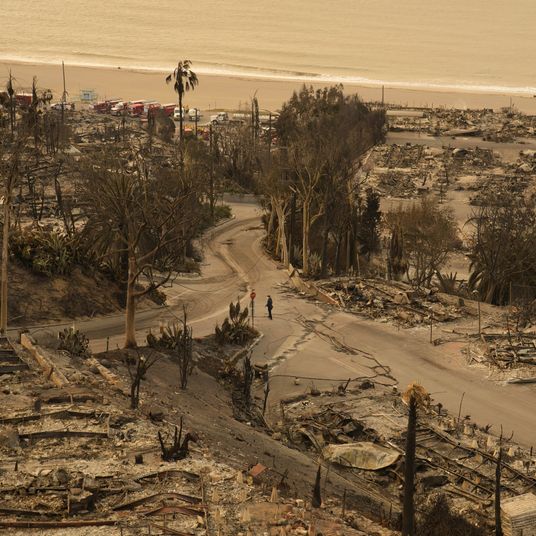
As Israel continues to besiege and bomb Gaza, the death toll there has climbed to at least 12,000 people, according to the Gaza Health Ministry — a large proportion of them children. As the horrific numbers rise, pressure is mounting for Israel to show that it has some military justification to bombard places like the Al-Shifa Hospital, which it maintains has been used as Hamas headquarters. To gain insight on how Israel draws up its targets — and the grim tradeoffs involved — I spoke with Michael A. Horowitz, the Middle East–based head of intelligence at Le Beck International, a security and risk firm. Hours after we spoke, Israel released further evidence from the hospital: video of what it claims is a Hamas tunnel underneath, and footage from October 7 of what appears to be hostages being herded into the facility.
I want to start with a specific and very high-profile example of Israel’s intelligence capabilities, or perhaps lack thereof, which is Al-Shifa Hospital.
This was never going to be fast. If you are the IDF and you think there is a command center under Shifa, you can go ahead and try to take Hamas by surprise, storm the building with hundreds of soldiers, and corner them. But that’s obviously the high-risk option, because if you do that, it’s going to be a bloodbath. There’s going to be a lot of victims, there’s going to be fights inside the hospital, your troops are going to suffer casualties, the patients are going to suffer casualties. It would be a nightmare. And I think that’s why we haven’t seen that. We’ve seen the opposite. The IDF is going relatively slow, building by building. They’re not really trying to corner whoever is in there.
When it comes to the information war, I think the goal really wasn’t to win over public opinion because the IDF knows you can’t. You have to storm the building, you have to storm the hospital. No one is going to think that whatever evidence you bring out after that will justify what happened before. So they’re really just trying not to lose the public-perception battle, and they’re going very slowly, and it’s clunky, and it’s underwhelming. But my point was wait a little bit, because this is going to take time.
Still, Israel has really hyped up this fact that there was an actual Hamas command center. They’ve used that terminology, and the U.S. has concurred with its intelligence. So it does seem like a lot is riding on finding it, because the cost of bombing this hospital has been grievous for Palestinians. If Israel doesn’t find what it was looking for, it would be another disaster on top of a humanitarian one.
There’s definitely a lot of pressure for them to find it. But again, they want to strike a balance. And I think there were also reports just before the IDF went in that the U.S. was pretty clear on what they did not want to see, which was actual fighting inside the hospital. Obviously, Israel is very sensitive to what the U.S. thinks, and by that I mean not just the public, but the actual decision-makers. If Israel in a few weeks has come up with nothing, then this is a huge failure on many levels. So there’s a lot of pressure.
But I’ve been working on this conflict for more than a decade, and it’s been an open secret that Hamas has — I wouldn’t call it a command center, I don’t have the evidence to say that, but that Hamas has a presence in Shifa. The question is what is that presence, and how much of it can you actually demonstrate to the world?
But if there is a network of tunnels below Shifa, and we know that there’s an underground level in Shifa, it’s going to take time for the IDF to get in there. They took Al-Rantisi Hospital, which is another hospital north of Shifa, and they found a tunnel that was 200 meters away from it. And they still haven’t entered it, because it’s very complicated to enter these kinds of underground facilities. You don’t want to send soldiers first. You want to send robots, you want to send dogs, you want to clear out the area, because obviously operating there is very difficult, very risky. So if there’s an actual underground network under Shifa that is a military one and not just the basement, this is going to take a long time. And even if you come out with evidence of a Hamas command center in two, three weeks, by then you’ve lost the narrative battle.
Zooming out a little to the broader military operation, to me it feels like one missing piece of all this is the way in which Israel picks its targets. They’re obviously killing a huge number of civilians, and to an outside observer, it certainly can look like they’re just indiscriminately bombing with no real plan. This is a general question, but when Israel hits, say, a certain apartment block, where did it get its information to do that? Is it mostly human sources, is it surveillance? Is it a mixture of everything?
It’s a lot of different things. You have collection tools like signal intelligence, communications, satellite imagery, and potentially human assets. The IDF has really worked to put all of this together. Four years ago, they created something called the Target Directorate inside military intelligence. The goal of this directorate is to produce targets, exactly like you mentioned — apartment blocks, or Hamas rocket stockpiles, tunnels, etc. And then they pass those along to the Navy, the Air Force, the artillery corps. So that’s the critical part of the IDF process. And it’s especially important for air strikes. They create targets every day, and then they pass it on to the rest of the army.
But I think it’s very important to highlight that this is different when you are striking from the air, and when you don’t have troops inside Gaza. Because when you have troops and there’s a threat, say an anti-tank missile that is fired from an apartment block, the time you have to respond to that threat is very, very different. And I think that’s what really makes urban warfare very ugly in my opinion, is that it’s really a zero-sum game between the risks that you are willing to let your troops take, and the risks that you are placing upon civilians. And I think the IDF is being very cautious about its troops, and that means that it’s being less cautious about civilian casualties.
Do you think they could have bettered that equation by waiting a little longer and doing a little more planning before they launched this ground operation? Are some of these civilian deaths just a product of haste?
I do think so, because at the end of the day, there’s a bank of targets. That’s what the target directorate does; it produces a bank of targets. But it’s very difficult to produce these targets, and it was especially difficult before October 7. Gaza wasn’t necessarily a priority. Iran, Syria, Hezbollah were seen as more of a priority. That means a lot of your intelligence is going to be focused there, rather than on Gaza. So after this surprise attack happens, you have to create a lot more targets. And also, your troops are suddenly there. That creates a lot of pressure, and that pressure increases the margin of error.
The magnitude of the intelligence failure on October 7 raises the question of whether anyone should trust the Israeli intelligence produced in the aftermath.
I’d say the October 7 failure is a little bit different than the question of which targets are being hit. The fact that there was no warning, and no one really saw it coming, was a massive mistake. But it has to do with analysis more than the collection. In the intelligence cycle, you have different types of processes. One of them is collection, which is just gathering intelligence, like signal intelligence, satellites, human, etc. And then there’s the analysis, which is where you produce an assessment.
The assessment, let’s say on October 6, was that Hamas was deterred, that Hamas did not want a war in Gaza. I think what happened, from what I’ve gathered from the reports that have been released, but also conversations with people I know in Israel, is that there was an overconfidence in that assessment, and that it was used to ignore a lot of the signs that actually pointed to the opposite, that Hamas was preparing for war. And it’s a very classic intel mistake. You want your collection — your facts, basically, or what’s closest to facts — to feed your assessments. You never want your assessment to negate the facts. But that happens a lot of the time, because in real life it’s very complex.
So that’s why I think the two things are very different. It’s definitely a fair question to ask whether we can trust the intelligence after what happened. But to me it’s really more about the zero-sum game of urban warfare, and also the pressure of suddenly having to focus so heavily on a region that was not on the top of your list. That means you have to produce a lot more targets and a lot more intelligence quickly.
I’m wondering how the intelligence agencies work with the political branch of this far-right Israeli government. Is there pressure from the top to produce targets? Could there be some level of interference going on?
There is pressure and definitely there is a political element to it. I would say specifically for really high-level items, like going for Shifa for instance, I think that has to be a political decision at some points, because it’s not just a military operation, it’s also something that will probably damage Israel’s image. That also means that there’s going to be a lot more pressure on Israel to stop. That definitely has to be vetted by the political echelon beforehand. And the decision to go into Gaza, for instance, is definitely a political one at some point.
But there’s been a lot of tensions between the military ranks and the political leadership in Israel. We’ve heard about that ever since this started, and the relationship between Netanyahu and his commanders was very bad to begin with.
And I’m not just talking about the intelligence community, but the military in general. The surprise attack came on the back of seven or eight months of political crisis in Israel, where the IDF kept trying to tell Netanyahu that his reforms were endangering the country, that Israel’s adversaries may take this as an opportunity to strike Israel. And Netanyahu did not want to listen. And I’m not saying that just as a metaphor — at some point, just before Netanyahu passed one of the judicial-reform bills, one of the generals came in to talk to him, and Netanyahu literally refused to see him. So that tells you a lot about the poisonous relationship that there was before October 7 between the political echelon and the military. And I don’t think it has improved since, since Netanyahu has been trying to pin the blame on the military. This is something that some people here have found revolting: that he has been trying to both deny his own responsibility — you’ve never seen him really acknowledge in a very clear-cut way that he’s responsible — and he’s been trying to pin the blame on the military. That has consequences.
There have been multiple wars between Israel and Hamas over the years, including in 2014 and 2008–09. Do you feel that in those conflicts, the intelligence that was used to strike targets was generally correct? In other words, what does the IDF’s track record on this look like?
If you look from a purely military perspective at how this campaign is going, ignoring the political side of this, and also the question of what comes after in Gaza — the military side is working fairly well. It looks like the army is doing its job. And again, that in the pure military sense, because obviously there’s a lot of Palestinian casualties. But we heard that taking Gaza would mean a thousand dead, a thousand soldiers killed in Gaza, and we’re very, very far from that. So in that sense, the military side is going very well. But the thing is, it’s such a different operation that you are putting a lot of risk on the civilian population. You can try to minimize it, but I’m not sure if I can say that the IDF is really striking the best balance on that.
I think that’s the $64,000 question right there.
Yeah, exactly. To me, it’s a very difficult question to answer, because to do that, you would have to compare it to other similar campaigns. And I don’t think the similar campaigns are the ones that you mentioned, like in 2014 and 2009, because those were very different.
This is more like Mosul, right?
Exactly, like Mosul. And even there, in Mosul, I’m talking off the top of my head here, but I remember that there were 4,000, 5,000 ISIS militants inside Mosul. We’re talking about 30,000 Hamas militants. We’re talking about tunnels. So even if you compare it to Mosul, it’s very, very different.
For instance, I looked at a strike that happened, I think, Saturday afternoon in southern Gaza. And the IDF has the means to strike a specific flat inside an apartment building and apparently, from the pictures that I’ve seen, that’s what happened. But half of the Gaza Strip has been evacuated to the south. So any apartment is going to be filled with civilians.
And the Palestinians reported 25 casualties, which is very much possible, even in one apartment. You can have 25 people just because of how dense Gaza is, and the fact that you’ve doubled the density of the south by asking people to evacuate. So this is going to be a very ugly war. It is already. And again, I think if the IDF wants to limit the number of casualties, their own — not the number of civilian casualties — they have to be less stringent on the rules of engagement. To me, that’s what explains the death toll. It’s not a moral justification, but I’m saying operationally, that’s how I see it.
This interview has been edited for length and clarity.






























